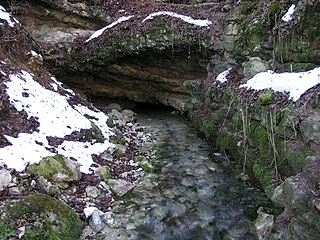Wulfbachquellhöhle
| Wulfbachquellhöhle
|
||
|---|---|---|
|
Wulfbachquelle near Mühlheim an der Donau |
||
| Location: | Swabian Alb | |
| Height : | 680 m above sea level NN | |
|
Geographic location: |
48 ° 2 '29.3 " N , 8 ° 53' 26.7" E | |
|
|
||
| Geology: | White Jura beta (ox 2) | |
| Type: | Water cave | |
| Discovery: | 1879 (first mentioned) | |
| Overall length: | 6583 m | |
The Wulfbachquellhöhle is an active water cave near Mühlheim an der Donau in Baden-Württemberg . With a measured 6583 meters (March 2018) it is the second longest cave in the Swabian Alb after the blue cave system . Since 1991 the cave has been explored by the cave research group Ostalb-Kirchheim (HFGOK).
cave
The cave is a typical creek or river cave. The cave system extends from the Wulfbach spring below the Kolbingen community to the north. In the first 1000 meters up to the break hall, the cave has several diving routes called siphons with a total length of 560 meters, which can only be explored by experienced cave divers. Then stream stretches come north in a corridor about 5 by 4 meters, which are repeatedly interrupted by sometimes huge collapse halls. At 2910 meters there is the largest cavity in the cave called "Wuba", 38 meters high, 21 meters wide and 86 meters long.
Main cave
After a crawl at the cave entrance, there is a tunnel that leads to the first, 12-meter-long siphon . A fall with a waterfall leads into the "Ammonite Hall", which is followed by the second, 39 meter long, siphon with an air bell. The third, 130 meter long siphon is reached through a box corridor after a right bend, which leads into the “Mühlheimer Halle”. This is an extended corridor that climbs backwards over boulders and at the foot of which the Mühlheimer Bach, dug deep into a layer of clay and gravel, flows. At the far end there is the 42 meter long and six meter deep fourth siphon, which ends at a fall front. That was the end of the cave for many years. The further path leads over a vertical passage beginning under water with two narrow passages into an air-filled chamber. The 240 meter long fifth siphon, which leads to the “Kolbinger Halle”, begins at the end of this. This is followed by the very narrow, 21-meter-long sixth siphon and the 27-meter-long seventh, which ends in the “two-stream hall”. From here the loamy eighth siphon leads after 30 meters into a box corridor. After two more siphons you will reach the “break hall”.
Wildlife
Well snails of the genus ( Bythiospeum ) with 1.8 to 5.4 millimeter high shells from the Wulfbachquell cave have been known since 1905 . Housing and living animals were screened out of the water at the cave exit. HFGOK dives were also able to detect the isopod ( Proasellus cavaticus ) and the strudelworm ( Dendrocoelum cavaticum ). The well snails are mainly to be found on the sediment-covered boulders in the bottom area up to the fourth siphon. There are only a few animals on the limestone walls encrusted with iron manganese or on the ceiling in this area.
source
The cave entrance forms the origin of the Wulfbach , whose source has a discharge of ten to 200 liters per second. The water has a temperature of 9 ° C all year round. The 24 square kilometer catchment area of the spring lies around the villages of Kolbingen and Renquishausen . The water from the Wulfsbach was used to supply Mühlheim and the old town with drinking water. The source was given up in 1938 after several typhoid infections. In later water analyzes, nitrate , nitrite and coliform bacteria were found that came from a sewage treatment plant on the plateau. The discharge has ended since the sewage treatment plant was connected to the sewer network in 2002.
Research history

The cave was first mentioned in writing in 1879 in the description of the Oberamt . A “mighty spring in a rock grotto” is mentioned. The Nürtingen geology professor Karl Löffler first recognized a cave behind the spring outlet in 1915. In 1957 the cave explorers Walter Eisele and Friedrich Bänisch examined the source outlet and began digging the following year. In 1959 they started the first diving attempts and they were able to penetrate 20 meters deep. In 1961/62 Jochen Hasenmayer explored the cave 350 meters to the "Mühlheimer Halle". Between 1984 and 1986 Axel Gnädiger succeeded in overcoming a narrow passage and explored the cave up to the "Gnädinger Fall" at 1160 meters. In 1991 members of the Kirchheim cave research group began to look at the cave as a research object. In May 1995 Rainer Straub and Andreas Kücha achieved their breakthrough and entry into the "Heuberghalle". In August 1997 more than six kilometers of corridors were documented. In 2000, after a fatal accident, the city of Mühlheim banned diving in the Wulfbachquellhöhle by issuing a police ordinance. An exemption is only possible in consultation with the HFGOK.
See also
literature
- Jürgen Bohnert, Siegfried Geiger, Herbert Jantschke, Andreas Kücha, Rainer Straub: The longest cave in the Swabian Alb DRW-Verlag 1998, ISBN 3-87181-391-5
- Herbert Jantschke: diving research of the HFGK in the Wulfbachquellhöhle (7919/32; Swabian Alb) , annual issue of the Arge Grabenstetten, 1996, pp. 46–52
supporting documents
- ↑ Longest and deepest caves in Germany. ARGE Höhle & Karst Grabenstetten eV, March 2018, accessed on March 30, 2019 .
- ↑ a b c Well snails from karst water caves (DATZ 2005/4)
- ↑ a b City of Mühlheim an der Donau - Wulfbachquellhöhle
- ↑ a b HFGOK - Wulfbachquellhöhle (Mühlheim)
Web links
- Rainer Straub: Wulfbachquellhöhle. germancavediving.de, accessed on November 1, 2008 .
- Cave Research Group Kirchheim (HFGOK)

